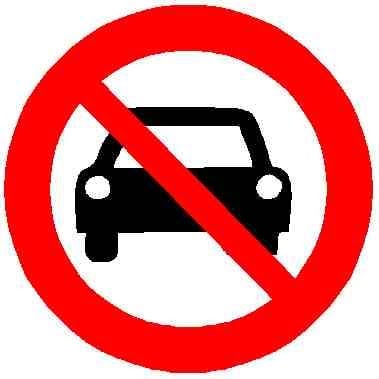Lol. I think we have like 10 yards of protected bike lanes in all of Albuquerque.
Love the “no shit, Sherlock” science
You mean being able to have the confidence that you can ride a bike without being subjected potential bodily harm at the hands of an apathetic drivers means more people will choose to ride their bike?
Color me shook.
SurprisedPikachu.png

If you’re on the browser on Lemmy UI, type
:pikachuand select it from the pop-up menu. It doesn’t work on the phone apps afaik.
I would ride a bike a lot more if the streets weren’t death traps.
I saw a guy the other day with a shirt that said “On street parking is theft”. I gave him a big thumbs up.
Theft of public space which needs to be maintained I might add (flood water drainage for a lot is not free for example), and it increases distance between points of interest (meaning lower density).
Having a way to get to work on a bike without getting killed is definitely an incentive.
Yup. Ever since my city placed these all over the place, commuting has been wonderful except for how everyone and their dog invade it as if it’s just part of the sidewalk.
The paper, titled “The link between low-stress bicycle facilities and bicycle commuting,” reports that protected bike lanes see about 1.8 times the number of bike commuters than standard bike lanes do and 4.3 times as many as blocks without bike lanes.
So doing the math, even an unprotected bike lane is about a 2.4 times improvement over no bike lane at all.
I find that to be an interesting contrast compared to a survey done in my city as part of a trails planning process, where planners asked respondents whether they “would recommend” use of bike infrastructure based on type. In that, only 8% of respondents would recommend using an unprotected bike lane and 14% were unsure, while 56% would recommend a bike lane with flex posts and 20% were unsure. In other words, respondents were between 3.5 and 7 times more likely to “recommend” use of a protected bike lane than an unprotected one.
I had suspected that that disparity in perception was greatly inflated compared to the actual difference in amount of use, and I’m glad to now have actual science to point to to back up that hunch. Thanks!
8% of respondents would recommend using an unprotected bike lane and 14% were unsure, while 56% would recommend a bike lane with flex posts
Flex posts are certainly better than a painted bicycle gutter, but they don’t offer any real protection like concrete barriers or a curb that can stop cars from entering
Excellent examples of that all around me where they installed a bunch of flex posts around previously unprotected bike lanes.
It’s been about a year (I think. Time is hard), and there are significantly less flex posts, some stretches have none at all anymore, because people just run them over like they don’t exist. Even on a street where the bike lane was ALREADY separated from the lane of travel by a ~5 foot section of cross-hatched pavement, people still somehow find a way to run over and destroy the poles. It’s baffling.
what’s wild to me is that they use posts that are obviously flexible, like why can they not just use hard plastic poles? it’s not gonna make jackshit difference for drivers beyond maybe scratching their paint more, but will look solid and actually discourage crossing them.
For the exceedingly rare instances when an emergency vehicle needs to access that area
but surely they could just crush the hard plastic bollards?
They’re more resilient if they’re only hit like once a year
It’s not (just) that; it’s that engineers incorrectly apply forgiving design and breakaway design principles for the benefit of drivers by default without really stopping to appreciate that a bike lane isn’t a valid space space for cars and needs to be unforgiving instead.
Also, flimsy plastic posts are way cheaper than proper bollards or curbs.
Ours had this till a great organization donated the parking curb concrete things that go in between the posts. So basically a concrete curb divider. It’s so much better and wasn’t too expensive compared.
All the more reason to be suspicious of the difference in perception being that high.
If I’m remembering a book I read (either Human Transit by Walker or Street Fight by Sadik-Khan, I forget), with protected bike lanes the gender disparity between cyclists also starts to disappear.
If I understand this study correctly, this is an increase of 11-14 bike commuters per mile of bike lane with a population density of 2,750 a square mile.
My city has 400 miles of bike lanes, therefore we should see an uptick in 5,600 riders?
I’m not sure how this study anticipates other factors limiting utilization such as economic status, weather, or city population size/density but it stands to reason that while a few more bike commuters can be coaxed out of hiding, there are very likely diminishing returns for investment costs and with 2 data points, the projected trajectory is not as linear as the study implies.
The investment costs for protecting a bike lane are almost nothing for any competent city, though. There’s a reason it’s possible for guerrilla urbanists to do it overnight with no money.
My city spends $150 million annually on this stuff.
Not asking you to dox yourself, but that number outside of context means very little.
If it costs almost nothing for a competent city and your city is spending $150M/year on it, well then the obvious conclusion is that your city isn’t competent! 🤓
But seriously, though, it’s funny 'cause it’s true: almost every city in the English-speaking world is incompetent at building bike infrastructure. The correct way to do it would be routinely as part of the standard operating procedure of maintaining the street. When you break it out as a separate retrofit project and then hold a big public input process about it, of course it’s going to massively inflate the cost.
(Also, I’m pretty sure @regul was talking about the costs only for upgrading bike lanes from unprotected to protected, not the total cost of bike infrastructure in general.)
I would expect it to be the opposite: that the returns would accelerate as the bike infrastructure network becomes more and more complete, until cyclist mode share approaches Dutch levels.






